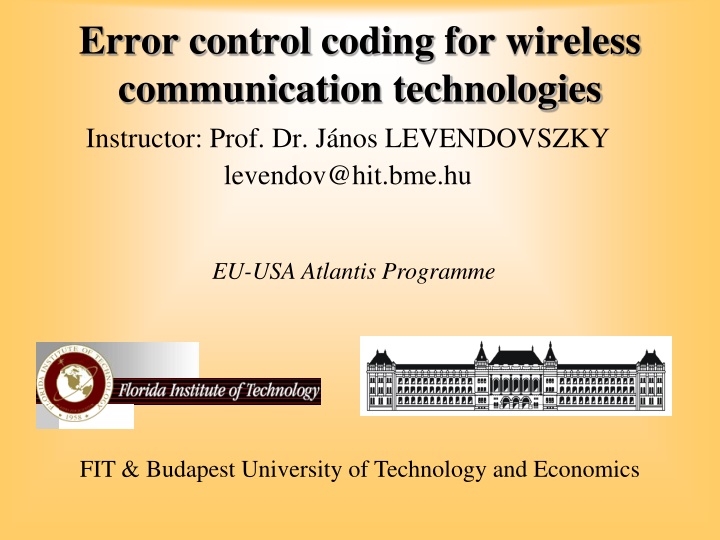
Error Control Coding for Wireless Communication Technologies with Prof. Dr. János Levendovszky
Explore error control coding for wireless communication technologies with insights from Prof. Dr. János Levendovszky. Topics include raised cosine, BER vs. SNR in QPSK, channel characterization, multipath propagation, and channel modeling for single-path and two-path propagation.
Download Presentation

Please find below an Image/Link to download the presentation.
The content on the website is provided AS IS for your information and personal use only. It may not be sold, licensed, or shared on other websites without obtaining consent from the author. If you encounter any issues during the download, it is possible that the publisher has removed the file from their server.
You are allowed to download the files provided on this website for personal or commercial use, subject to the condition that they are used lawfully. All files are the property of their respective owners.
The content on the website is provided AS IS for your information and personal use only. It may not be sold, licensed, or shared on other websites without obtaining consent from the author.
E N D
Presentation Transcript
Error control coding for wireless communication technologies Instructor: Prof. Dr. J nos LEVENDOVSZKY levendov@hit.bme.hu EU-USA Atlantis Programme FIT & Budapest University of Technology and Economics
Characterization of the wireless channel Transmitter shadowing Receiver Receiver Mutipath propagation wavelength Received Power (PRX) 0 dB -50 dB Path loss Larg-scal fading -100 dB Small-scale fading Distance (d) 1km 2km 2025. 03. 19.. T MOP 4.1.2-08/2/A/KMR-2009-0006 8
Multipath propagation ISI !! Consequences of fading: Error probability is dominated by the probabilty of being in a fading dip. Deterministic modeling of channel at each point is very difficult. Statistical modeling of system behavior. QoS (e.g.: BER) 2025. 03. 19.. T MOP 4.1.2-08/2/A/KMR-2009-0006 9
Channel modeling: single-path propagation Radio channel Ideal propagation (only attenuation) 2 4 1 r = Attentuation a G G T R , G G Tx and Rx antenna gains T R Example: Compute the attenuation of a radio link r=10km, G_T and G_R both 20 db, f=450 MHz 2 4 1 4 r r = = dB dB T dB R Attentuation 20lg a a G G G G T R = = = = 8 8 / 3*10 /4.5*10 0.666 f c c f m 4 10,000 0.666 = 40 105.5-40=65.5dB = dB 20lg a = = 0.28 W 1 W P P in out
Channel modeling: two-path propagation Direct and reflected h_T 2 h h h_R = + = + j ; E E E E E e T r R 0 0 0 R r 2 r ( ) 2 dB = dB dB T dB R a O r Attentuation 20lg a G G h h T R ( ) = + 2 j f 1 H f e ( ) 2 H f
Impact on BER Pb 1 Without fading 10-1 Fading 1/x 10-2 10-3 10-2: 13-times Tx power 10-5: 5012-times Tx power 10-4 SNR [dB] 10-5 0 10 20 30 Selective fading is one of the most dominant effects which impairs the quality of radio communication !
Multipath propagation Severe distortions in the frequency characteristics which results in bad quality radio communication (very high Bit Error Rate).
The noise Thermal noise: electronic noise generated by the thermal agitation of the charged carriers (usually the electrons) inside an electrical conductor at equilibrium. The power spectral density of thermal noise depends on the environment temperature Te that antenna sees . (Note: white power spectral density, gaussian p.d.f.) Man-made noise: Spurious emmision: electric devices have it (e.g car ignitions), it is not necessarily Gaussian-distributed, but in theory it is assumed Gaussian anyway. Coexistence of other wireless systems: wireless communication systems operate at same time in unlicensed bands (eg.: 2.45-GHz ISM band). Receiver noise: the amplifiers and mixers in the RX are noisy, and thus increase the total noise power.
Man-made noise 2025. 03. 19.. T MOP 4.1.2-08/2/A/KMR-2009-0006 15
Modeling the thermal noise Noise energy density kB=1.38x10-23 J/K is Boltzmann constant. It is usually assumed that the environmental temperature is isotropically 300K, therefore N0 = -174 dBm/Hz. hf hf = = = ( ) s f kT N 0 hf kT / hf KT 1 e + + 1 .... 1 N0 f White Gaussian Noise (WGN) in radio domain 2025. 03. 19.. T MOP 4.1.2-08/2/A/KMR-2009-0006 16
The noise power The noise power: PN = N0B where B is the bandwidth in Hz, using logarithmic units: PN[dBm] = -174 + 10lg( B ) Hw: Calculate the SNR of a 10km radio link assuming single-path propagation power at the frequency 450 MHz in the frequency band 100kHz assuming 1mW Tx power!
Statistical description Sample from the noise process: 2 x N ( ) 1 = 2 0, ( ) N N f x e 0 0 t 2 N 0
Statistical description cont n 2 i x = 1 1 N i ( ) ( ) ( ) = = 2 0 I ,..., , ,..., N N f x x e 0 0 1 t t n ( ) n 1 n 2 N 0 Samples from the noise process:
Characterization of the radio channel summary Single path propagation model ( ) f = noise s N kTB AWGN 0 Full characterization with SNR Attenuation Multi-path propagation model ( ) f = noise s N kTB AWGN 0 Attenuation H(f) Full characterization with impulse response and SNR
Summary Challenges of wireless communication technologies Resources vs. algorithms in order to cope with the energy and spectral constraints Modeling the source Modeling the radio channel (propagation models, linear distortion, noise)












